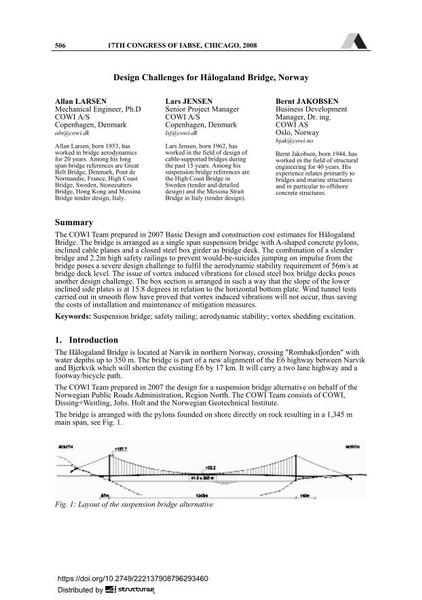Design Challenges for Hålogaland Bridge, Norway

|
|
|||||||||||
Bibliografische Angaben
| Autor(en): |
Allan Larsen
Lars Jensen Bernt Jakobsen |
||||
|---|---|---|---|---|---|
| Medium: | Tagungsbeitrag | ||||
| Sprache(n): | Englisch | ||||
| Tagung: | 17th IABSE Congress: Creating and Renewing Urban Structures – Tall Buildings, Bridges and Infrastructure, Chicago, USA, 17-19 September 2008 | ||||
| Veröffentlicht in: | IABSE Congress Chicago 2008 | ||||
|
|||||
| Seite(n): | 506-507 | ||||
| Anzahl der Seiten (im PDF): | 8 | ||||
| Jahr: | 2008 | ||||
| DOI: | 10.2749/222137908796293460 | ||||
| Abstrakt: |
The COWI Team prepared in 2007 Basic Design and construction cost estimates for Hålogaland Bridge. The bridge is arranged as a single span suspension bridge with A-shaped concrete pylons, inclined cable planes and a closed steel box girder as bridge deck. The combination of a slender bridge and 2.2m high safety railings to prevent would-be-suicides jumping on impulse from the bridge poses a severe design challenge to fulfil the aerodynamic stability requirement of 56m/s at bridge deck level. The issue of vortex induced vibrations for closed steel box bridge decks poses another design challenge. The box section is arranged in such a way that the slope of the lower inclined side plates is at 15.8 degrees in relation to the horizontal bottom plate. Wind tunnel tests carried out in smooth flow have proved that vortex induced vibrations will not occur, thus saving the costs of installation and maintenance of mitigation measures. |
||||
| Stichwörter: |
Hängebrücke
|
||||
